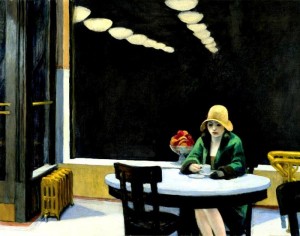The new exhibit at The New York Public Library, “ Lunch Hour,” is chock-full of artifacts, stories, and memories that will feed your curiosity about meals quickly consumed and forgotten. One enlightening tidbit is the definition of lunch during the 18th century. Samuel Johnson defined lunch “as much food as one’s hand can hold.” (From the “lunch” entry in Johnson’s Dictionary of the English Language, 1755.)
Exploring New York City “lunch hour”, the rich displays reveal a complicated tale of time, culinary fashion, and social meanings. Anthropologists and school children will be amused by the wall display of metal lunchboxes irresistible. The entire exhibit covers the evolution of the luncheonette, cafeterias, school lunches, and the power lunch, just for starters. The limited time available for eating the midday meal put pressure on entrepreneurs and customers as industrialization put a premium on productivity at the office and factory.
By the mid-1800s, New Yorkers were finding new ways to eat that took less time out of their workday. The density of New York neighborhoods made it easy to capitalize on the proximity of “luncheonettes” and cafeterias. Old menus from some of these quick-lunch places reveal the expediency and inventiveness required by café owners in order to provide speedy and convenient ways to dine. Restaurant and luncheonette owners used rubber stamps to print the names of new dishes and prices on their printed menus, telegraphing a just-in-time adjustment to the availability of food and the desire to please their pressured clientele.
The displays about the New York Automat, the invention of two German immigrants, Joe Horn and Frank Hardart, tell how they launched a factory-like food dispensary that lasted until 1991. Walls of the windowed little boxes, containing such lunchtime fare as macaroni and cheese and fresh doughnuts, are reconstructed in the exhibit, providing a sense of what it must have been like to spin into one of these places with your handful of nickels, the amount required to unlock one of those little doors. Video displays show clips from movies shot on locations that featured Horn and Hardart Automats, including a film that portrayed a budding romance that blossomed between a beautiful woman and her nickel on one side of the boxes and a handsome man on the other side, who whispered his desires through the small portal.
The evolution of the sandwich, including the soft bouncy slices of Wonder Bread, and the invention of peanut butter (invented for children and at first made spreadable by the addition of chile sauce and mayonnaise), add meaning to a lunchtime standby that has recently reinvented itself into a burrito or a wrap.
Charity lunches occupy one room of the exhibit, introduced by urban reformers like Jacob Riis who saw the city fail to provide food for its poorer inhabitants. During the Depression, New York City attempted to solve unemployment by acquiring mountains of apples for the jobless to sell, filling street corners with apple vendors, but only solving the employment crisis until New Yorkers became fed up with apples.
The exhibit concludes with menus and photos from the heady years of the 1980’s “power lunch.” Iconic restaurants such as Sardis, The Algonquin Club and Delmonico’s provided a visible space to conclude business deals and to engage in the art of networking. Restaurant entrepreneurs worked to attract their celebrity clientele, creating lunchtime legends such as Dorothy Parker and Harold Ross.
“Lunch Hour” is a well-designed exhibit and reveals the many layers of New York’s food culture, including names such as Schrafft’s and Chock-full-of Nuts. You will leave with a new appetite for understanding the implications of our digital world. The only notable exception to an otherwise comprehensive display is the food truck. Mobile food, now so popular in today’s urban food scene, began decades ago and its story would complete the telling of “The Lunch Hour. Check out this exhibit here http://www.nypl.org/events/exhibitions/lunch-hour-nyc-0. Lunch Hour continues until February 2013.
The NY Library exhibit is a must see. The library staff has done an amazing job putting it together. There are four main themes and the portion on Horn & Hardart was even better than the one the City Museum of NY did a few years back.
The library is even carrying Horn & Hardart coffee in their gift shop. It’s an opportunity to buy some great coffee and support the library at the same time.
Al Mazzone
HornAndHardartCoffee.com